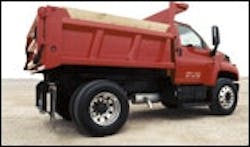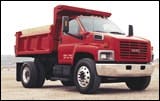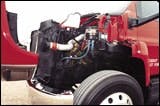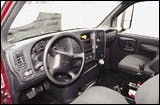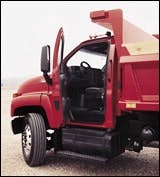|
Test Set
Truck: GMC C7500, conventional daycab, 105-in. BBC, GVW 35,000 lbs. Engine: Caterpillar 3126E, 7.2 liters (440 cubic inches), 275 hp/860 lbs.-ft. Clutch: Eaton 14-in. 2-plate Solo self-adjusting Transmission: Eaton Fuller RT-8709B 9-speed Axles: 12,000-lb. Meritor 23090S front, 23,000-lb. Dana Spicer rear, w/4.11 ratio Brakes: Meritor S-cam full air Fuel capacity: 50- and 25-gal. steel tanks Body: Heil 9-foot/6-yard steel |
Think "big truck" in General Motors terms and the names Chevrolet Kodiak and GMC TopKick leap to mind. For almost 20 years, since GM got out of the heavy-duty truck business, these have been GM's stoutest trucks. Recognizable labels have sales value, so the latest generation of GM's midrange vehicles also get the Kodiak and TopKick labels.
Of course, they also wear alpha-numeric designations—C (for conventional-cab) 6500, 7500 and 8500, indicating their Class 6, 7 and 8 weight ratings, thanks to hefty frames, suspensions, axles and other chassis components. They've got more power and interior space and comfort than ever before, plus some clever engineering and maintenance features.
These are the heavier versions of the GMT560 range introduced more than a year ago. We wrote up a C4500 in CE's November '01 issue; the 4500 and 5500 went into production in January, while the recently shown-off 6500 through 8500 began coming down the line at Flint, Mich., in June.
The red Chevy C7500 dump truck pictured here is a good example of a heavy Chevy or Jimmy (remember when GMCs were "Jimmys"?). This is a stubby truck set up for a landscaper or excavating contractor who'd tote some dirt and maybe pull an equipment trailer, said Mike Eaves, an assistant brand manager at GM headquarters. For trailer pulling, its gross combination weight rating would be 35,000 pounds.
Longer wheelbases of up to 308 inches are available, and in the C8500, you can order tandem axles that push gross vehicle weight ratings to 61,000 pounds. At the other end, the C6500's GVW rating starts at 19,501 pounds. Extra-long frames in various models will take bodies up to 30 feet long.
The "7500" suggests a Class 7 truck (26,001 to 33,000 pounds gross), though this one is rated at 35,000 pounds, which nudges it into Class 8—and lets you pay the 12 percent federal excise tax when you buy it. Better to spec it at under 33,000 pounds and save a few thousand bucks, it seems to me, even if you give up a ton or so of payload.
Pay for the big-rig feel?
Then again, maybe you should pay extra for the nice, big-rig feel this Chevy C7500 had. That came from its high stance, powerful Cat diesel and Fuller 9-speed manual transmission. The non-synchro transmission separates the rookies from the big truckers, and you have to be a double-clutchin' character to drive it well.
Of course, really experienced drivers can shift without the clutch, and GM engineers seem to have done a good job of setting up the transmission in the chassis to allow this. I did a little "float shifting," but a better idea is to get fully acquainted with a truck's mechanical nuances before trying to waltz footless through the gears.
With an Allison automatic, you need no big-truck experience at all, at least if you stay off the street. CE's managing editor, Katie Weiler, reported that she drove a C8500 through a demo course at a Chicago-area introduction. Other non-truckers did the same with some of the larger trucks at the demo I attended at the Las Vegas Motor Speedway.
Actually, most of the newspaper writers present tended to stick with the Chevy Express and GMC Savana panel and window vans also shown off at this event. But they'd have felt at home in the Kodiaks and TopKicks, because their cabs are derived from the vans.
Economies of volume
Putting a light-duty cab on a medium- to heavy-duty truck saves money, as there are tremendous economies of scale in stamping hundreds of thousands of metal panels versus a few thousand produced for a typical "premium" truck cab. If you beef up the cab to take the extra beating that a heavier truck will get, as GM engineers say they have, then why not?
The cab lives longer, anyway, if you can filter out some of the on- and off-road shock. Eaves said the rear of a Kodiak/TopKick cab sits on rubber mounts, and nylon-steel "Hystek" mounts are optional. Door hinges are bolted to the jambs instead of welded, as on the C/K-based cab used in the now-discontinued C series. Handles have a rugged feel, which shouldn't be surprising because the doors of vans are opened and closed a lot and are engineered for such arduous repetition.
You may or may not like the streamlined West Coast mirrors the designers have come up with. Under each mirror head a single supporting arm reaches far out to try to put the glass behind the top of the steeply sloping windshield, where you can see what's behind. But they work, and the arm will snap free if the head collides with something. That'll save a few bucks.
Outward visibility is exceptional, with huge windows and a steeply sloping hood allowing the driver to spot things on the ground as close as 17 feet from the front bumper, Eaves said. From the old C, that distance was as much as 30 feet.
The new cab is wider, longer and taller, and noticeably more roomy. The instrument panel is decidedly automotive in design, which big truckers may sneer at. But instruments and controls are logical and easy to see and operate—user-friendly, to borrow a computer cliche.
I couldn't make a judgment on quietness, as I barely got up to 45 miles an hour because we were restricted to a large parking lot. I did whip through some tight turns to enjoy the exceptional maneuverability. Wide-track front axles allow a sharp wheel cut, and set-back positioning of the axle shortens the wheelbase. A stabilizer bar allows a lower spring rate, softening the ride.
Maintenance made easier
Tilt the hood and you may groan at the piping and wiring that block your view of the engine. Under all that stuff is a Cat 3126E (or Duramax diesel or Vortec 8100 gasoline engine, depending on what you've ordered), but how are you supposed to work on it?
First, all fluids can be easily checked because dipsticks and bottles are gathered on the left side. With a little neck craning you can see belts, hoses and anything else that's part of the driver's pre-trip inspection (assuming he or she bothers with it).
For serious mechanical work, the accessories can be quickly removed in modules. Service people have timed the removal processes, and most take well under an hour. For instance, removing engine-mounted air conditioning compressor and hoses takes under a half-hour. Quick-disconnect fittings keep the system sealed, so refrigerant need not be recharged after reassembly.
This Cat was a 275—pretty gutsy—while 300 horsepower is the top commercial rating. With hefty frames and tandem rear axles in the data book, wouldn't more power be appropriate? Marketing people are thinking about slipping in the upcoming C-9 diesel, due out in January as Cat's answer to Cummins' ISL and International's HT530.
Installing the C-9 would require some enlarging of the underhood space, but would almost bring back the Brigadier, a low-cost and therefore popular Class 8 truck and tractor not built since the mid-'80s. But that's another name and another old story.
About the Author
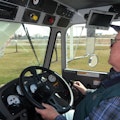
Tom Berg
Tom Berg is widely acknowleged as one of the top truck writers in the industry. He has covered construction for more than 34 years, and has test-driven well over 150 trucks for Construction Equipment.
